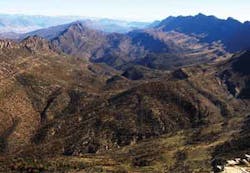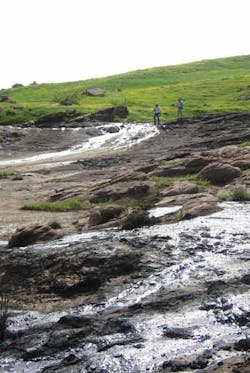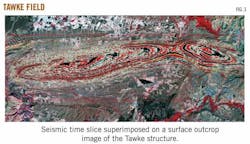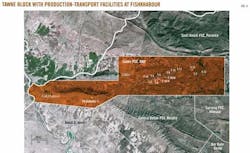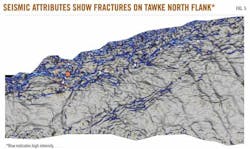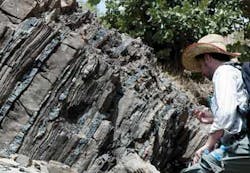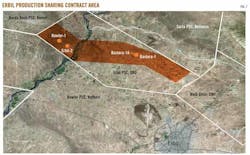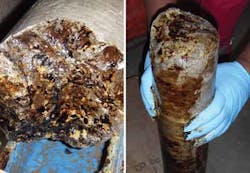Tore Lilloe-Olsen
Nils A. Bang
DNO International ASA
Oslo
The oil business abounds with "geological explorers." One might think that these geologists would be satisfied with simply finding the oil, then leaving it to reservoir and production engineers to get it out of the ground and off to market.
If DNO International activities in Kurdistan are any indication, nothing can be further from the truth.
The Kurdistan region of Iraq is a windswept, remote area that in turn seems both intimidating as well as ultimately fascinating (Fig. 1). In 2004, the region was unexplored when the Norwegian company DNO International became the first western enterprise in 3 decades to sign a production sharing contract there, seemingly an unlikely spot for the small, dynamic company to be setting up operations. Still, the potential gains outweighed the risks involved, and the company chose to follow its vision: "When others hesitate, then we go in."
Brick by brick
DNO covers the entire spectrum, from exploration, to development, to production, a cohesive team that includes geology "explorers" firmly committed to the "brick by brick" building of knowledge and experience—providing a solid base for work that brings together all aspects of the geology-reservoir-production process.
From a geologist's perspective, this includes analysis of remote data, field work, and mapping with local geologists, mapping of the large-scale geology and key detachment zones, as well as the collecting and sampling of rock data.
Then, once the regional framework is solidly in place, seismic acquisition and processing begin, followed by drilling, coring, logging, sampling, and lab analysis. The process moves onward to well completion and flow stimulation techniques, and finally, well testing and production. When all these steps take place in harmony and coordination, it is then that true sustainable success can be achieved.
Iraq: the world's 4th largest
Iraq is a country of diversity, from the arid sand deserts in the south to the rugged, remote mountains in the far north.
It is a nation in development and change, one that is extremely oil rich. According to the reference book "The Petroleum Geology of Iraq,"1 as of 2004 there were 17 giant and supergiant oil fields in Iraq, each containing more than 1 billion bbl of initial oil reserves.
The British Petroleum 2010 Statistical Review of World Energy credits Iraq with a total of 115 billion bbl, making it the country with the fourth largest oil reserves on the planet.
Adding in OPEC's reported Iraqi cumulative oil production of 32 billion bbl, this brings the total to an initial oil reserve of 147 billion bbl. These numbers may vary according to the source for obvious reasons; it has simply been extremely difficult to document the hydrocarbon potential during the past 2 decades of turmoil in the country.
Rivers, lakes, and ancient roads of oil
Kurdistan is located in a region that many experts designate as the "birthplace of civilization," where the ancient empire of Mesopotamia was located.
This area is known today as northern Iraq and Syria, located between the Tigris River, the Zagros Mountains, and the Lesser Zab River. Mesopotamia is widely considered to be the first urban civilization and featured such innovations as ancient highways with a bitumen oil substance created and paved during the reign of King Hammurabi, who ruled from 1792-50 BC.
The key issue upon DNO's entry into Kurdistan—as it remains so today—was not only to identify, locate, and quantify the subsurface accumulations but also to find fields that would be sustainable over a long period. The "best" reservoirs were the ones that could be positively identified with a good combination of matrix and fracture porosity, good fluid properties—ones that can be produced at good rates.
From a geologist's perspective, the geology and geological formations are nothing less than fascinating in this area of Kurdistan. Oil often leaks right to the surface, and at higher temperatures the oil become less viscous and may even create rivers of oil (Fig. 2). This is a clear indicator of mature source rock and oil in the ground.
First discovery
Tawke was the subject of intense exploration during the early years of exploration that began in 2004.
Although the company has undertaken oil exploration, development, and production operations in Yemen for more than 10 years, it is here in Kurdistan where activities have typified the company's ideology: daring to be on the front lines in search of nothing less than a "world class field."
Through a combination of satellite intelligence, local area knowledge, field research, and good old-fashioned hard work, DNO had charted the possibilities for development of several major oil fields, with a primary focus on Tawke (Fig. 3).
It was 2 years after signing the initial PSC that first announcement was made of DNO's first major oil discovery.
Due to a process of ongoing research and analysis, at that time (2006) the company was hesitant to make a 100% concrete estimate concerning the amount of oil reserves located at Tawke, but based on available data were certain that the field contained at least 100 million bbl of oil, a substantial find by any measure.
600+ million bbl
From 2006 onwards, activities continued at Tawke through an ongoing process of exploration, drilling, and extensive data acquisition.
The focus was the development of a complete database using input received through high-quality 3D seismic data, the drilling of 15 wells in order to develop the field and continuously calibrate the reservoir models, and then the upstart of rudimentary production.
These activities, combined with local on site knowledge, have enabled DNO to nearly double the prognosis for recovery from approximately 20% to 36% with a high level of confidence.
This also allowed the estimated reserve in Tawke field to be first raised to 230 million bbl in 2007, and based on recent work and production history adjusted upwards to more than 600 million bbl in 2011.
40 years of oil
At the original rate of production that averaged 50,000 b/d, this would mean that it would take up to 4 decades to realize the full potential of Tawke field, so it has been a natural development to plan for increasing the production capacity over time.
The original level of production averaging 50,000 b/d of oil was increased to a proved sustainable production capacity of nearly 70,000 b/d in 2011. Always looking with a view to the future, the company's strategy is to bring proved sustainable production capacity to a level of 100,000 b/d in 2012 and then increase that capacity to 200,000 b/d in the future.
The key elements of the logistic operations include the central processing facility at Tawke, where the crude is stabilized before being transported through the 42-km pipeline that connects Tawke field to Iraqi National Oil Co.'s export installation at Fishkhabour.
Fishkhabour is the gate to the international marketplace, a "gate" that opened for DNO in January 2011 when the Kurdistan Regional Government and Iraqi federal authorities agreed to commence crude oil exports from Kurdistan. The Fishkhabour facilities also contain a loading station for trucks, allowing DNO to supply oil to the local market (Fig. 4).
The giant might grow
Plans for the continued expansion of production and sale of oil from DNO Kurdistan are in place. At the same time, DNO is not content to believe that "only" 600 million bbl of oil are available in the Tawke reservoir.
Continuing efforts are being made to maximize the recovery of the oil that exists in Tawke, and through the most modern technology available explore what additional oil might be found even at greater depths than the current average of 2,000 m or in areas outside current production.
In other words, Tawke is far from yet fully explored, and as an "oil explorer" this author is greatly anticipating the next steps.
DNO has been able to extend the mapping of the field updip of the existing wells, and current expectations are that the flank will be found to be more fractured. The next well to be drilled is known as "T-16," located on the northern extension of the flank of the field, as having been identified and mapped by DNO's most recent seismic data (Fig. 5).
The jewels of Kurdistan
The seismic reflectors of the Cretaceous indicate an updip extension of the structure, not properly imaged and mapped on the previous processed data sets, and it is the main objective of the T-16 well to test this model.
The prognosis is that this will help to provide a better understanding of the full potential of Tawke field, which could have significant volumes of recoverable oil in addition to the current documented reserves. All told, the three Kurdistan PSCs (Tawke, Erbil, and Duhok) operated by DNO are estimated to contain around 6 billion bbl of gross oil equivalent in place.
Following the drilling of T-16, the next step will be to drill a well to penetrate the deeper formations below Tawke field, called Tawke Deep.
Some of the Tawke wells are tagging the top Jurassic, the Sargelu source rock, but no well has penetrated the entire Jurassic and Triassic potential reservoir sequences, and this also represents a significant upside in the field (Fig. 6).
The Erbil PSC contains the Benenan and Bastora heavy oil discoveries, while the Dohuk PSC contains the Summail, currently considered to be a heavy oil discovery with a gas cap (Figs. 7 and 8).
Large-scale production of heavy oil will call for more technology and more competence and capacity going forward, and innovative solutions will be required. Given this type of reporting from the "front lines," one can certainly understand why the oil potential in Kurdistan is gaining more international interest.
Kurdistan's first horizontal well
An excellent example of an innovative solution and how knowledge was accrued in a step-by-step fashion can be found at the Erbil PSC at the Benenan and Bastora discoveries.
After the Jurassic oil discoveries in Benenan, DNO drilled the Bastora-1 well and discovered oil in the Cretaceous Bekhme formation, a formation that was not present on the adjacent Benenan discovery. The Bekhme core indicated an obvious oil stain, a relatively tight reservoir rock with limited matrix and fracture porosity, and oil that was visibly present (Fig. 9).
The challenge was then to gain the most knowledge possible of this Bekhme formation, and the situation looked like an excellent candidate for a horizontal well, potentially providing a larger contact area to the Bekhme formation.
After careful coordination and gaining support for these activities, the company decided to drill the first-ever horizontal well undertaken in Kurdistan. Utilizing the existing vertical well, available maps and seismic attribute maps, a horizontal section was landed that was parallel contours, penetration through mounds of good reservoir and through areas likely to contain fracture systems.
The end result was that DNO managed to identify and to follow the preferred Lower Bekhme interval. Compared with the vertical well, very good test rates were achieved and perhaps most importantly from a long term perspective there was much practical and reservoir knowledge gained that will help the company optimize the development of the Erbil PSC.
International feel, local strength
Integral to DNO's success has been to gain the trust and respect of the local population.
Coming into the country during time of changes demanded the ability to gain this solid trust and over time coordinated efforts with local and national governmental officials, oil and gas experts, the business sector, and the population in general.
The head of DNO exploration and subsurface teams in Kurdistan, Nils Bang, has used the better part of a decade in building up an international team that has become a center of excellence on fractured carbonate geology, with the Kurds playing an important role.
Logistics in Kurdistan are a challenge, but the invaluable contact network that the company has developed has been key to success. The fact that DNO in Kurdistan was, and still is, managed by Kurds at the company's local office in Erbil has proven to be of vital importance in this respect.
DNO is committed to Kurdistan for the long run. It is a challenging environment, but this is the personality of the company, realizing that calculated risks can bring great rewards to all stakeholders, whether they be the local population, shareholders, or the Iraqi and Kurdistan governments, all of whom are reaping benefits from the ongoing activities being conducted here.
Risk and reward in Iraq
Perhaps it has been this author's 2 decades and some odd years in the energy business that has had a profound effect on the "explorer personality," but satisfaction is not experienced simply by the oil being found; such satisfaction will not be realized until the oil has been brought to the surface, processed, and shipped in a way that is sustainable to all stakeholders involved.
Although the oil seems to and literally often does flow in rivers, there are challenges on all levels, governmental, practical, cultural, economical, and societal.
The bottom line is that great potential for success exists, and what lies beyond the horizon of long-term possibilities in Kurdistan are limited only by the imagination.
Reference
1. Aqrawi, A.A.M., Goff, J.C., Horbury, A.D., and Sadooni, F.N., "The Petroleum Geology of Iraq," Scientific Press Ltd., Beaconsfield, Bucks, UK, 2011, 424 pp.
The authors
More Oil & Gas Journal Current Issue Articles
More Oil & Gas Journal Archives Issue Articles
View Oil and Gas Articles on PennEnergy.com
